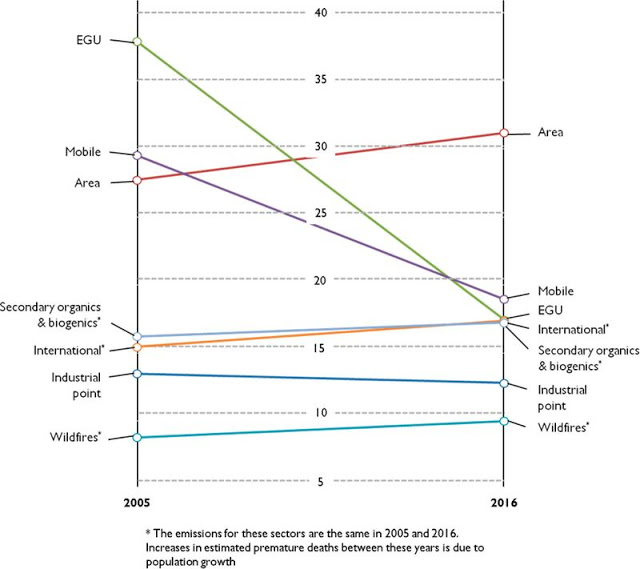Recent risk assessments have characterized the overall burden of recent PM2.5 and ozone levels on public health, but generally not the variability of these impacts over time or by sector. Using photochemical source apportionment modeling and a health impact function, we attribute PM2.5 and ozone air quality levels, population exposure and health burden to 23 industrial point, area, mobile and international emission sectors in the Continental U.S. in 2005 and 2016. Our modeled policy scenarios account for a suite of emission control requirements affecting many of these sectors. Between these two years, the number of PM2.5 and ozone-related deaths attributable to power plants and mobile sources falls from about 68 000 (90% confidence interval from 48 000 to 87 000) to about 36 000 (90% confidence intervals from 26 000 to 47 000). Area source mortality risk grows slightly between 2005 and 2016, due largely to population growth. Uncertainties relating to the timing and magnitude of the emission reductions may affect the size of these estimates. The detailed sector-level estimates of the size and distribution of mortality and morbidity risk suggest that the air pollution mortality burden has fallen over time but that many sectors continue to pose a substantial risk to human health.
If you liked this article, please give it a quick review on ycombinator or StumbleUpon. Thanks

Brian Wang is a Futurist Thought Leader and a popular Science blogger with 1 million readers per month. His blog Nextbigfuture.com is ranked #1 Science News Blog. It covers many disruptive technology and trends including Space, Robotics, Artificial Intelligence, Medicine, Anti-aging Biotechnology, and Nanotechnology.
Known for identifying cutting edge technologies, he is currently a Co-Founder of a startup and fundraiser for high potential early-stage companies. He is the Head of Research for Allocations for deep technology investments and an Angel Investor at Space Angels.
A frequent speaker at corporations, he has been a TEDx speaker, a Singularity University speaker and guest at numerous interviews for radio and podcasts. He is open to public speaking and advising engagements.


